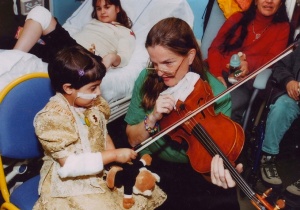The Healing Power of Music: An Interview with Penny Brill
by Jessica Ryan
Penny Anderson Brill has explored the connection between art and healing in a personal way. A graduate of Juilliard, she joined the Pittsburgh Symphony Orchestra in 1980, as a violist. Yet her commitment to music and its potential impact has taken her not only to the stage but also to area hospitals and wellness programs. Her work in bringing art to healing environments has attracted international attention, and I wanted to learn more about this artist who has translated her virtuosity into serving the wellness of many over the years.
What are music and wellness programs?
In music and wellness programs, professional musicians collaborate with credentialed music therapists to expand the presence of music in healthcare facilities. Unlike regular symphony performances, music and wellness programs are developed primarily to meet listeners’ physical, social, and emotional needs.
Music and wellness programs are interactive and participatory. For my programs, I choose music intended to engage, calm, or energize listeners. I select music that I think will meet audience members’ needs, and adjust what I’m doing based on the feedback I receive during my programs.
What made you decide to start a music and wellness program at the PSO?
I started my own program 10 years before the PSO’s program began because I believed in the power of music to help people optimize their quality of life, particularly in stressful times. Ultimately, I hope my programs will give people the tools to use music to help themselves.
Over the years I kept inviting the PSO to become involved with the program. Several years ago the PSO hired a community projects staff member who was from a family of nurses. She was comfortable dealing with hospitals and was able to forge a partnership with Children’s [The Children’s Hospital of Pittsburgh of UPMC]. There was a huge value to formalizing this partnership because it gave the PSO a new opportunity to reach out to the whole community, rather than a limited demographic. Orchestras in general need to move more in the direction of serving the whole community, and the PSO used its relationship with Children’s as a starting point toward reaching this goal.
Once I had the support of orchestra staff I also had help with PR and personnel coordination. Staff took on a great deal of my managerial tasks so that I could focus more on preparing musicians for venues. It was to our mutual benefit to run the program together. On my end, it meant that someone else could apply for funding, I had more credibility with outside organizations, and I could implement the program more quickly. For the PSO it meant positive PR and an opportunity to engage community members in a way it hadn’t done before.
Describe your mindset for a regular symphony performance, and then your mindset for a music and wellness program. How do the two differ, and how are they the same?
When I go on stage for an orchestral performance, someone else has picked the music and chosen the tempo and interpretation for me. I can use my skills to perform the selected interpretation convincingly. I notice the audience and its reaction, but I am part of a collective experience. I can’t reach out to individual audience members.
When I go with one or two other players to a healthcare venue and there are 50-100 individuals I can interact with, I can design my own program and modify the program as I go along. The experience is more of a conversation between the audience and me. Audience members give instantaneous feedback about what worked and what didn’t work, and that feedback affects what I do next.
I get a lot of personal satisfaction in successfully identifying music that will help my audience. My goal is to empower audience members, and that makes me stronger. If people need and want what I’m offering them and they react positively, I feel valued; and that is profoundly satisfying.
What value do symphony orchestras find in conducting both symphonic concerts and music and wellness programs?
Musicians can go into hospitals to learn more about their communities. When musicians know more about who their community members are, what their concerns are, and what they like and respond to, this can affect orchestral programming. Symphony musicians can use the knowledge they gain to ensure that their music is vibrant, relevant, and accessible to audience members. By increasing their relevance, symphonies will help more community members come to know and appreciate orchestral music.
On the other hand, orchestral music can create a listener experience that can’t be replicated using a small group in a hospital setting. The rich variety of sounds coming out of an orchestra can provide a person with a sense of something that exists that is much larger than the individual. When people listen to an orchestra, the sound can wash over them, overwhelm them, and penetrate every cell of their bodies. In that way it can have a profound effect on their emotions. Because of the rich history of symphonic music, orchestras can also help people connect with many generations of human experience in a very positive way.
What is your main goal for symphonic music and wellness programs?
My goal is to implement music and wellness programs in the places where people are open to having them. I’ve always been a big advocate of doing things that the community values, so I want to make it easy for people to adapt the music and wellness model to many locations.
_____
Links to further resources, and related articles from The Muse Dialogue:
A biography of Penny Anderson Brill
“Healing Art: One Part Imitation, One Part Imagination,” by Jessica Ryan
“Hospital Design: What Difference Does It Make?” by Jessica Ryan
“A Helper in Times of Trouble,” by Janette Delgado.




Trackbacks & Pingbacks